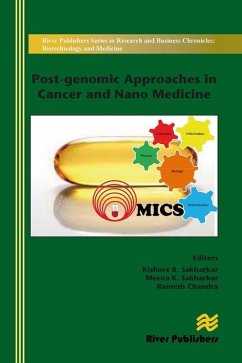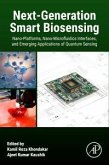Loutfy H. Madkour
Nano-Carbons for Nanobiosensing and Bioremediation in Smart Targeted Cancer Treatment
Versandkostenfrei innerhalb Deutschlands
502,99 €
inkl. MwSt.
Versandkostenfrei*
Erscheint vorauss. 29. Mai 2026
Melden Sie sich
hier
hier
für den Produktalarm an, um über die Verfügbarkeit des Produkts informiert zu werden.

251 °P sammeln
Loutfy H. Madkour
Nano-Carbons for Nanobiosensing and Bioremediation in Smart Targeted Cancer Treatment
- Broschiertes Buch
This book focuses the applications of Nanostructured carbon materials (NCMs) in all fields of pharmacy and medicine from therapeutics to analysis and diagnosis.
Andere Kunden interessierten sich auch für
![Post-Genomic Approaches in Cancer and Nano Medicine Post-Genomic Approaches in Cancer and Nano Medicine]() Post-Genomic Approaches in Cancer and Nano Medicine49,99 €
Post-Genomic Approaches in Cancer and Nano Medicine49,99 €![Nano Biosensors for Non-Invasive Diagnosis of Cancer Nano Biosensors for Non-Invasive Diagnosis of Cancer]() Nano Biosensors for Non-Invasive Diagnosis of Cancer28,99 €
Nano Biosensors for Non-Invasive Diagnosis of Cancer28,99 €![Utilization Of Male Targeted Short Message Service To Enhance Family Planning Uptake Utilization Of Male Targeted Short Message Service To Enhance Family Planning Uptake]() Vincent Omwenga MatokeUtilization Of Male Targeted Short Message Service To Enhance Family Planning Uptake42,99 €
Vincent Omwenga MatokeUtilization Of Male Targeted Short Message Service To Enhance Family Planning Uptake42,99 €![Future of Internet of Bio-Nano Things in Personalized Healthcare Future of Internet of Bio-Nano Things in Personalized Healthcare]() Future of Internet of Bio-Nano Things in Personalized Healthcare150,99 €
Future of Internet of Bio-Nano Things in Personalized Healthcare150,99 €![Ultrashort Pulse Lasers and Ultrafast Phenomena Ultrashort Pulse Lasers and Ultrafast Phenomena]() Takayoshi KobayashiUltrashort Pulse Lasers and Ultrafast Phenomena138,99 €
Takayoshi KobayashiUltrashort Pulse Lasers and Ultrafast Phenomena138,99 €![Next-Generation Smart Biosensing Next-Generation Smart Biosensing]() Next-Generation Smart Biosensing133,99 €
Next-Generation Smart Biosensing133,99 €![Breakthroughs in Smart City Implementation Breakthroughs in Smart City Implementation]() Breakthroughs in Smart City Implementation45,99 €
Breakthroughs in Smart City Implementation45,99 €-
-
-
This book focuses the applications of Nanostructured carbon materials (NCMs) in all fields of pharmacy and medicine from therapeutics to analysis and diagnosis.
Produktdetails
- Produktdetails
- Verlag: Taylor & Francis Ltd
- Seitenzahl: 600
- Erscheinungstermin: 29. Mai 2026
- Englisch
- Abmessung: 280mm x 210mm
- ISBN-13: 9781041227946
- ISBN-10: 1041227949
- Artikelnr.: 75617679
- Herstellerkennzeichnung
- Libri GmbH
- Europaallee 1
- 36244 Bad Hersfeld
- gpsr@libri.de
- Verlag: Taylor & Francis Ltd
- Seitenzahl: 600
- Erscheinungstermin: 29. Mai 2026
- Englisch
- Abmessung: 280mm x 210mm
- ISBN-13: 9781041227946
- ISBN-10: 1041227949
- Artikelnr.: 75617679
- Herstellerkennzeichnung
- Libri GmbH
- Europaallee 1
- 36244 Bad Hersfeld
- gpsr@libri.de
Loutfy H. Madkour is a Full Professor of Physical chemistry, Nanoscience and Nanotechnology at Tanta University (Egypt) and Al Baha University (Saudi Arabia). He is a contributing Researcher and Editor to Chemistry World. He has more than 20 years of experience in science: research, writing and editing in condensed-matter, Corrosion Science and Advanced Structured Materials relating to Nanoscience, Nanomaterials, Technology/Nanotechnology/Biotechnology, Cancer Nanomedicine, and Drug Delivery. He received his BSc, MSc, and PhD in Physical Chemistry from the Cairo, Minia, and Tanta Universities in Egypt, respectively. He has conducted a series of studies in various areas of the field of Physical chemistry: electrochemistry, electroanalytical chemistry, corrosion science, density functional theory (DFT), molecular dynamic simulation, quantum chemistry, theoretical chemistry, chemical equalization principles, nanoscience, nanotechnology, nanomedicine, nanotoxicology, electrometallurgy, analytical chemistry, polarography, electrolytic extraction of heavy metals from natural ores and deposits, electrochemical thermodynamics, and environmental chemistry. His earlier research included the biosynthesis of metallic nanoparticles (MNPs) as well as toxicology studies for pharmacological applications in nanomedicine and therapy. He has published 200 peer-reviewed original research articles, 26 review articles, 8 book chapters and 12 books in the area of physical and environmental chemistry, advanced structural nanomaterials, corrosion science, nanoelectronics materials, advancements and Innovations in energy storage, cancer nanomedicine, drug delivery and nanotoxicology. He is appointed as the prestigious Editorial Board member of several international journals. His name has been listed in the top 2% of the most distinguished and influential scientists globally according to the ranking and database of Stanford American University of Scientists globally in (2022). He obtained Award: ISAO in the year (2022): "Lifetime Achievement Award" in the International Scientist Awards on Engineering, Science and Medicine. He obtained Awards: ISAO in the years (2022, 2021 and 2020): "Distinguished Scientist Award" in the International Research Awards on Science, Technology, and Management. He is also an editorial board member of several international journals.
Foreword. Preface. Acknowledgment. About the author. Introduction. Summary.
Chapter 1 Biomedical Applications for Direct Drug Delivery Carriers and
Cancer Therapy- Based Carbon Nanotubes Porins (CNTPs). Chapter 2 Novel
Strategies-Based Versatile Carbon Nanoplatforms for Cancer Therapeutics.
Chapter 3. Carbon Nanotubes (CNTs) Carriers-Based Biomimetic Inherent
Medication Therapeutic Drug Delivery Systems (DDS). Chapter 4Carbon
Nanotubes-Based Diagnosis and Novel Emerging Target Drug Delivery Systems
for Anticancer Therapies. Chapter 5 Strategies of Targeted Smart Drug Gene
Therapy and Immunosensing for Carbon-Based Nanomaterials as Anticancer
Mediators Nanoparticles. Chapter 6 Bioimaging Strategies Utilizing Carbon
Nanomaterials (CNMs) for Biomolecules, Microorganisms and Virus Detection.
Chapter7.Carbon-Based Nanomaterials for Targeted Cancer Nanotherapy:
Controlled Drug Delivery Systems Design and Development Strategies. Chapter
8 Emerging Strategies and Cutting-Edge Progress (CNMs) in Drug Delivery to
Improve Cancer Treatment: Surface Modification and Biological Interaction.
Chapter 9 Strategies-Based CNTs and Fullerenes as Smart Drug Co-Delivery
Nanocarriers for Cancer Nanotherapy: Future of Translational
Nanomedicine.List of Abbreviations. Index.
Foreword. Preface. Acknowledgment. About the author. Introduction. Summary.
Chapter 1Recent Developments and Future Prospects In vitro and In vivo of
CNTs Nanocarriers for-Targeted Drug Delivery System. Chapter 2 Carbon
Nanotubes as Targeting Therapeutic Arsenal for Blood Brain Cancer Tumors
Diseases-Based Novel Drug Delivery Platforms. Chapter 3 Carbon
Nanomaterials as Emerging Nanocarriers for the Anti-Cancer Targeting Drug
Delivery Doxorubicin: Improved Novel Cancer Therapy Technologies. Chapter 4
Novel Technologies Toward Intervention Carbon Family-Based Nanomaterials
for Detection, Diagnosis and Cancer Therapeutics. Chapter 5
Pharmacokinetics, Biodistribution and Intracellular Energy Metabolism
Aspects of Carbon Nanomaterials: Improving Novel Outcomes of
Functionalization for Biomedical Applications. Chapter 6 Cytotoxicity
Profile of Carbon Nanomaterials as an Effective Anticancer Drug Carriers.
Chapter 7 Novel Tumor-Targeting Drug Delivery Systems Based- Carbon
Nanomaterials in Cancer Treatment. Chapter 8 Carbon-Based Nanomaterials
(CBNMs) as Emerging Platform for Anticancer Nanotherapy: Novel Strategy and
Future Prospects. Chapter 9 Recent Advancements of Carbon Dots Strategy
Based Effective Novel Photosensitizers and Anticancer Drug Delivery System.
References. Index.
Foreword. Preface. Acknowledgment. Author Biograph. Introduction. Summary.
Chapter 1 Carbon Nanotube Composites: Fundamentals and Synthesis Ways.
Chapter 2 Basic Working Strategies and Implementation Principles of Nano
Carbons Family Composites-Based Biosensors and Sensing Devices. Chapter 3
Mechanisms and Classifications of Carbon-Based Chemical, Physical and Field
Effect Transistors (FETs) Biosensors as Sensing Platform. Chapter 4
Carbon-Based Nanomaterials (CBNMs) in Drug Delivery and Biomedical
Applications for Cancer Diagnosis and Therapy. Chapter 5 Graphene-Based
Biomedical Sensor Materials and Anticancer Drug Delivery Systems (DDSs).
Chapter 6 Current Trends and Future Potential in Carbon Nanomaterials
(CNMs)-Based High-Sensitivity Electrical Gas/Vapor Strain Sensors. Chapter
7 Recent Developments in Doped/Co-Doped Carbon Nanodots (CNDs) as Booming
Material in Biomedicine Applications. Chapter 8 Advances Development in
Processing Carbon Dots Composites and their Surface Modification Strategies
Methods for Bioremediation Technological Applications. Chapter 9
Two-Dimensional Graphitic Carbon Nitride (g-C3N4)-Based Nanoplatforms
Emerging Electrochemical and Biosensors for Healthcare and Biomedical
Applications. Chapter 10 Carbon Nanotubes-Based Intelligent Platform for
Cancer Vaccine Development Co-delivery Nanocarriers Immunotherapy
Achievements: Challenges In vitro and In vivo. Chapter 11 Unique Principal
Properties and for Electrochemical BiosensorsBased on Functional
Nanomaterials. Appendix: List of abbreviations. Index
Chapter 1 Biomedical Applications for Direct Drug Delivery Carriers and
Cancer Therapy- Based Carbon Nanotubes Porins (CNTPs). Chapter 2 Novel
Strategies-Based Versatile Carbon Nanoplatforms for Cancer Therapeutics.
Chapter 3. Carbon Nanotubes (CNTs) Carriers-Based Biomimetic Inherent
Medication Therapeutic Drug Delivery Systems (DDS). Chapter 4Carbon
Nanotubes-Based Diagnosis and Novel Emerging Target Drug Delivery Systems
for Anticancer Therapies. Chapter 5 Strategies of Targeted Smart Drug Gene
Therapy and Immunosensing for Carbon-Based Nanomaterials as Anticancer
Mediators Nanoparticles. Chapter 6 Bioimaging Strategies Utilizing Carbon
Nanomaterials (CNMs) for Biomolecules, Microorganisms and Virus Detection.
Chapter7.Carbon-Based Nanomaterials for Targeted Cancer Nanotherapy:
Controlled Drug Delivery Systems Design and Development Strategies. Chapter
8 Emerging Strategies and Cutting-Edge Progress (CNMs) in Drug Delivery to
Improve Cancer Treatment: Surface Modification and Biological Interaction.
Chapter 9 Strategies-Based CNTs and Fullerenes as Smart Drug Co-Delivery
Nanocarriers for Cancer Nanotherapy: Future of Translational
Nanomedicine.List of Abbreviations. Index.
Foreword. Preface. Acknowledgment. About the author. Introduction. Summary.
Chapter 1Recent Developments and Future Prospects In vitro and In vivo of
CNTs Nanocarriers for-Targeted Drug Delivery System. Chapter 2 Carbon
Nanotubes as Targeting Therapeutic Arsenal for Blood Brain Cancer Tumors
Diseases-Based Novel Drug Delivery Platforms. Chapter 3 Carbon
Nanomaterials as Emerging Nanocarriers for the Anti-Cancer Targeting Drug
Delivery Doxorubicin: Improved Novel Cancer Therapy Technologies. Chapter 4
Novel Technologies Toward Intervention Carbon Family-Based Nanomaterials
for Detection, Diagnosis and Cancer Therapeutics. Chapter 5
Pharmacokinetics, Biodistribution and Intracellular Energy Metabolism
Aspects of Carbon Nanomaterials: Improving Novel Outcomes of
Functionalization for Biomedical Applications. Chapter 6 Cytotoxicity
Profile of Carbon Nanomaterials as an Effective Anticancer Drug Carriers.
Chapter 7 Novel Tumor-Targeting Drug Delivery Systems Based- Carbon
Nanomaterials in Cancer Treatment. Chapter 8 Carbon-Based Nanomaterials
(CBNMs) as Emerging Platform for Anticancer Nanotherapy: Novel Strategy and
Future Prospects. Chapter 9 Recent Advancements of Carbon Dots Strategy
Based Effective Novel Photosensitizers and Anticancer Drug Delivery System.
References. Index.
Foreword. Preface. Acknowledgment. Author Biograph. Introduction. Summary.
Chapter 1 Carbon Nanotube Composites: Fundamentals and Synthesis Ways.
Chapter 2 Basic Working Strategies and Implementation Principles of Nano
Carbons Family Composites-Based Biosensors and Sensing Devices. Chapter 3
Mechanisms and Classifications of Carbon-Based Chemical, Physical and Field
Effect Transistors (FETs) Biosensors as Sensing Platform. Chapter 4
Carbon-Based Nanomaterials (CBNMs) in Drug Delivery and Biomedical
Applications for Cancer Diagnosis and Therapy. Chapter 5 Graphene-Based
Biomedical Sensor Materials and Anticancer Drug Delivery Systems (DDSs).
Chapter 6 Current Trends and Future Potential in Carbon Nanomaterials
(CNMs)-Based High-Sensitivity Electrical Gas/Vapor Strain Sensors. Chapter
7 Recent Developments in Doped/Co-Doped Carbon Nanodots (CNDs) as Booming
Material in Biomedicine Applications. Chapter 8 Advances Development in
Processing Carbon Dots Composites and their Surface Modification Strategies
Methods for Bioremediation Technological Applications. Chapter 9
Two-Dimensional Graphitic Carbon Nitride (g-C3N4)-Based Nanoplatforms
Emerging Electrochemical and Biosensors for Healthcare and Biomedical
Applications. Chapter 10 Carbon Nanotubes-Based Intelligent Platform for
Cancer Vaccine Development Co-delivery Nanocarriers Immunotherapy
Achievements: Challenges In vitro and In vivo. Chapter 11 Unique Principal
Properties and for Electrochemical BiosensorsBased on Functional
Nanomaterials. Appendix: List of abbreviations. Index
Foreword. Preface. Acknowledgment. About the author. Introduction. Summary.
Chapter 1 Biomedical Applications for Direct Drug Delivery Carriers and
Cancer Therapy- Based Carbon Nanotubes Porins (CNTPs). Chapter 2 Novel
Strategies-Based Versatile Carbon Nanoplatforms for Cancer Therapeutics.
Chapter 3. Carbon Nanotubes (CNTs) Carriers-Based Biomimetic Inherent
Medication Therapeutic Drug Delivery Systems (DDS). Chapter 4Carbon
Nanotubes-Based Diagnosis and Novel Emerging Target Drug Delivery Systems
for Anticancer Therapies. Chapter 5 Strategies of Targeted Smart Drug Gene
Therapy and Immunosensing for Carbon-Based Nanomaterials as Anticancer
Mediators Nanoparticles. Chapter 6 Bioimaging Strategies Utilizing Carbon
Nanomaterials (CNMs) for Biomolecules, Microorganisms and Virus Detection.
Chapter7.Carbon-Based Nanomaterials for Targeted Cancer Nanotherapy:
Controlled Drug Delivery Systems Design and Development Strategies. Chapter
8 Emerging Strategies and Cutting-Edge Progress (CNMs) in Drug Delivery to
Improve Cancer Treatment: Surface Modification and Biological Interaction.
Chapter 9 Strategies-Based CNTs and Fullerenes as Smart Drug Co-Delivery
Nanocarriers for Cancer Nanotherapy: Future of Translational
Nanomedicine.List of Abbreviations. Index.
Foreword. Preface. Acknowledgment. About the author. Introduction. Summary.
Chapter 1Recent Developments and Future Prospects In vitro and In vivo of
CNTs Nanocarriers for-Targeted Drug Delivery System. Chapter 2 Carbon
Nanotubes as Targeting Therapeutic Arsenal for Blood Brain Cancer Tumors
Diseases-Based Novel Drug Delivery Platforms. Chapter 3 Carbon
Nanomaterials as Emerging Nanocarriers for the Anti-Cancer Targeting Drug
Delivery Doxorubicin: Improved Novel Cancer Therapy Technologies. Chapter 4
Novel Technologies Toward Intervention Carbon Family-Based Nanomaterials
for Detection, Diagnosis and Cancer Therapeutics. Chapter 5
Pharmacokinetics, Biodistribution and Intracellular Energy Metabolism
Aspects of Carbon Nanomaterials: Improving Novel Outcomes of
Functionalization for Biomedical Applications. Chapter 6 Cytotoxicity
Profile of Carbon Nanomaterials as an Effective Anticancer Drug Carriers.
Chapter 7 Novel Tumor-Targeting Drug Delivery Systems Based- Carbon
Nanomaterials in Cancer Treatment. Chapter 8 Carbon-Based Nanomaterials
(CBNMs) as Emerging Platform for Anticancer Nanotherapy: Novel Strategy and
Future Prospects. Chapter 9 Recent Advancements of Carbon Dots Strategy
Based Effective Novel Photosensitizers and Anticancer Drug Delivery System.
References. Index.
Foreword. Preface. Acknowledgment. Author Biograph. Introduction. Summary.
Chapter 1 Carbon Nanotube Composites: Fundamentals and Synthesis Ways.
Chapter 2 Basic Working Strategies and Implementation Principles of Nano
Carbons Family Composites-Based Biosensors and Sensing Devices. Chapter 3
Mechanisms and Classifications of Carbon-Based Chemical, Physical and Field
Effect Transistors (FETs) Biosensors as Sensing Platform. Chapter 4
Carbon-Based Nanomaterials (CBNMs) in Drug Delivery and Biomedical
Applications for Cancer Diagnosis and Therapy. Chapter 5 Graphene-Based
Biomedical Sensor Materials and Anticancer Drug Delivery Systems (DDSs).
Chapter 6 Current Trends and Future Potential in Carbon Nanomaterials
(CNMs)-Based High-Sensitivity Electrical Gas/Vapor Strain Sensors. Chapter
7 Recent Developments in Doped/Co-Doped Carbon Nanodots (CNDs) as Booming
Material in Biomedicine Applications. Chapter 8 Advances Development in
Processing Carbon Dots Composites and their Surface Modification Strategies
Methods for Bioremediation Technological Applications. Chapter 9
Two-Dimensional Graphitic Carbon Nitride (g-C3N4)-Based Nanoplatforms
Emerging Electrochemical and Biosensors for Healthcare and Biomedical
Applications. Chapter 10 Carbon Nanotubes-Based Intelligent Platform for
Cancer Vaccine Development Co-delivery Nanocarriers Immunotherapy
Achievements: Challenges In vitro and In vivo. Chapter 11 Unique Principal
Properties and for Electrochemical BiosensorsBased on Functional
Nanomaterials. Appendix: List of abbreviations. Index
Chapter 1 Biomedical Applications for Direct Drug Delivery Carriers and
Cancer Therapy- Based Carbon Nanotubes Porins (CNTPs). Chapter 2 Novel
Strategies-Based Versatile Carbon Nanoplatforms for Cancer Therapeutics.
Chapter 3. Carbon Nanotubes (CNTs) Carriers-Based Biomimetic Inherent
Medication Therapeutic Drug Delivery Systems (DDS). Chapter 4Carbon
Nanotubes-Based Diagnosis and Novel Emerging Target Drug Delivery Systems
for Anticancer Therapies. Chapter 5 Strategies of Targeted Smart Drug Gene
Therapy and Immunosensing for Carbon-Based Nanomaterials as Anticancer
Mediators Nanoparticles. Chapter 6 Bioimaging Strategies Utilizing Carbon
Nanomaterials (CNMs) for Biomolecules, Microorganisms and Virus Detection.
Chapter7.Carbon-Based Nanomaterials for Targeted Cancer Nanotherapy:
Controlled Drug Delivery Systems Design and Development Strategies. Chapter
8 Emerging Strategies and Cutting-Edge Progress (CNMs) in Drug Delivery to
Improve Cancer Treatment: Surface Modification and Biological Interaction.
Chapter 9 Strategies-Based CNTs and Fullerenes as Smart Drug Co-Delivery
Nanocarriers for Cancer Nanotherapy: Future of Translational
Nanomedicine.List of Abbreviations. Index.
Foreword. Preface. Acknowledgment. About the author. Introduction. Summary.
Chapter 1Recent Developments and Future Prospects In vitro and In vivo of
CNTs Nanocarriers for-Targeted Drug Delivery System. Chapter 2 Carbon
Nanotubes as Targeting Therapeutic Arsenal for Blood Brain Cancer Tumors
Diseases-Based Novel Drug Delivery Platforms. Chapter 3 Carbon
Nanomaterials as Emerging Nanocarriers for the Anti-Cancer Targeting Drug
Delivery Doxorubicin: Improved Novel Cancer Therapy Technologies. Chapter 4
Novel Technologies Toward Intervention Carbon Family-Based Nanomaterials
for Detection, Diagnosis and Cancer Therapeutics. Chapter 5
Pharmacokinetics, Biodistribution and Intracellular Energy Metabolism
Aspects of Carbon Nanomaterials: Improving Novel Outcomes of
Functionalization for Biomedical Applications. Chapter 6 Cytotoxicity
Profile of Carbon Nanomaterials as an Effective Anticancer Drug Carriers.
Chapter 7 Novel Tumor-Targeting Drug Delivery Systems Based- Carbon
Nanomaterials in Cancer Treatment. Chapter 8 Carbon-Based Nanomaterials
(CBNMs) as Emerging Platform for Anticancer Nanotherapy: Novel Strategy and
Future Prospects. Chapter 9 Recent Advancements of Carbon Dots Strategy
Based Effective Novel Photosensitizers and Anticancer Drug Delivery System.
References. Index.
Foreword. Preface. Acknowledgment. Author Biograph. Introduction. Summary.
Chapter 1 Carbon Nanotube Composites: Fundamentals and Synthesis Ways.
Chapter 2 Basic Working Strategies and Implementation Principles of Nano
Carbons Family Composites-Based Biosensors and Sensing Devices. Chapter 3
Mechanisms and Classifications of Carbon-Based Chemical, Physical and Field
Effect Transistors (FETs) Biosensors as Sensing Platform. Chapter 4
Carbon-Based Nanomaterials (CBNMs) in Drug Delivery and Biomedical
Applications for Cancer Diagnosis and Therapy. Chapter 5 Graphene-Based
Biomedical Sensor Materials and Anticancer Drug Delivery Systems (DDSs).
Chapter 6 Current Trends and Future Potential in Carbon Nanomaterials
(CNMs)-Based High-Sensitivity Electrical Gas/Vapor Strain Sensors. Chapter
7 Recent Developments in Doped/Co-Doped Carbon Nanodots (CNDs) as Booming
Material in Biomedicine Applications. Chapter 8 Advances Development in
Processing Carbon Dots Composites and their Surface Modification Strategies
Methods for Bioremediation Technological Applications. Chapter 9
Two-Dimensional Graphitic Carbon Nitride (g-C3N4)-Based Nanoplatforms
Emerging Electrochemical and Biosensors for Healthcare and Biomedical
Applications. Chapter 10 Carbon Nanotubes-Based Intelligent Platform for
Cancer Vaccine Development Co-delivery Nanocarriers Immunotherapy
Achievements: Challenges In vitro and In vivo. Chapter 11 Unique Principal
Properties and for Electrochemical BiosensorsBased on Functional
Nanomaterials. Appendix: List of abbreviations. Index







